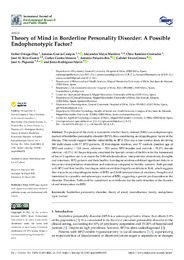Por favor, use este identificador para citar o enlazar este ítem:
https://hdl.handle.net/11000/31074Registro completo de metadatos
| Campo DC | Valor | Lengua/Idioma |
|---|---|---|
| dc.contributor.author | Ortega-Díaz, Esther | - |
| dc.contributor.author | Garcia-Campos, Jonatan | - |
| dc.contributor.author | Moya-Martínez, Alejandro | - |
| dc.contributor.author | Ramírez-Cremades, Clara | - |
| dc.contributor.author | RICO GOMIS, JOSÉ MARÍA | - |
| dc.contributor.author | Cuesta-Moreno, Carlos | - |
| dc.contributor.author | Palazón-Bru, Antonio | - |
| dc.contributor.author | Estan-Cerezo, Gabriel | - |
| dc.contributor.author | Piqueras, José A. | - |
| dc.contributor.author | Rodríguez-Marín, Jesús | - |
| dc.contributor.other | Departamentos de la UMH::Ciencias del Comportamiento y salud | es_ES |
| dc.contributor.other | Departamentos de la UMH::Estadística, Matemáticas e Informática | es_ES |
| dc.contributor.other | Departamentos de la UMH::Medicina Clínica | es_ES |
| dc.contributor.other | Departamentos de la UMH::Psicología de la Salud | es_ES |
| dc.date.accessioned | 2024-02-05T12:46:23Z | - |
| dc.date.available | 2024-02-05T12:46:23Z | - |
| dc.date.created | 2021-03-19 | - |
| dc.identifier.citation | Int. J. Environ. Res. Public Health 2021, 18, 3193 | es_ES |
| dc.identifier.issn | 1660-4601 | - |
| dc.identifier.issn | 1661-7827 | - |
| dc.identifier.uri | https://hdl.handle.net/11000/31074 | - |
| dc.description.abstract | The purpose of this study is to examine whether theory of mind (ToM) is an endophenotypic marker of borderline personality disorder (BPD), thus constituting an etiopathogenic factor of the disease. This would suggest familial vulnerability to BPD. This was a case-control study involving 146 individuals with 57 BPD patients, 32 first-degree relatives, and 57 controls (median age of BPD and control = 33.4 years; relatives = 52.9 years; BPD females and controls = 91.2%; female relatives = 62.5%). All the participants completed the Spanish version of the Movie for the Assessment of Social Cognition test to evaluate the ToM subclassification: interpretation of emotions, thoughts and intentions. BPD patients and their healthy first-degree relatives exhibited significant deficits in the correct interpretation of emotions and intentions compared to healthy controls. Both patients with BPD and their healthy first-degree relatives exhibited significant deficits in ToM, which suggests that it may be an etiopathogenic factor of BPD, and ToM (interpretation of emotions, thoughts and intentions) is a possible endophenotypic marker of BPD, suggesting a genetic predisposition to the disorder. Therefore, ToM could be considered as an indicator for the early detection of the disorder of and intervention for BPD. | es_ES |
| dc.format | application/pdf | es_ES |
| dc.format.extent | 12 | es_ES |
| dc.language.iso | eng | es_ES |
| dc.publisher | MDPI | es_ES |
| dc.rights | info:eu-repo/semantics/openAccess | es_ES |
| dc.rights | Attribution-NonCommercial-NoDerivatives 4.0 Internacional | * |
| dc.rights.uri | http://creativecommons.org/licenses/by-nc-nd/4.0/ | * |
| dc.subject | Borderline personality disorder | es_ES |
| dc.subject | Theory of mind | es_ES |
| dc.subject | Mentalization | es_ES |
| dc.subject | Family | es_ES |
| dc.subject | Endophenotypic marker | es_ES |
| dc.title | Theory of Mind in Borderline Personality Disorder A Possible Endophenotypic Factor | es_ES |
| dc.type | info:eu-repo/semantics/article | es_ES |
| dc.relation.publisherversion | https://doi.org/10.3390/ijerph18063193 | es_ES |

Ver/Abrir:
Theory of Mind in Borderline Personality Disorder A Possible.pdf
398,68 kB
Adobe PDF
Compartir:
 La licencia se describe como: Atribución-NonComercial-NoDerivada 4.0 Internacional.
La licencia se describe como: Atribución-NonComercial-NoDerivada 4.0 Internacional.
.png)